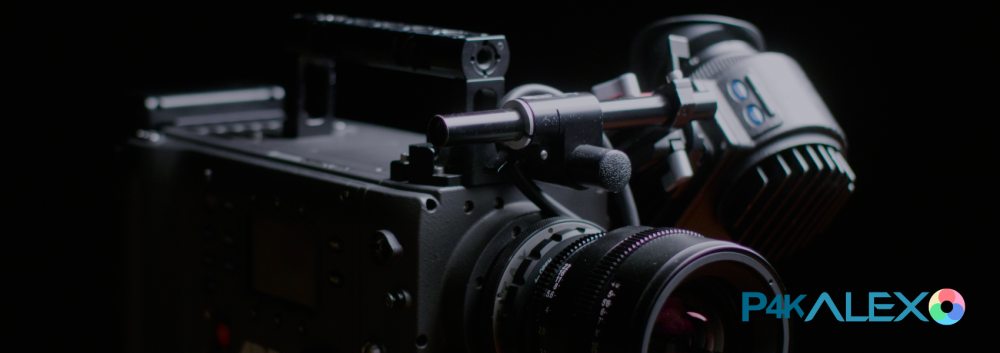-
Posts
659 -
Joined
-
Last visited
Content Type
Profiles
Forums
Articles
Everything posted by Sage
-
Not accurately, though it'll work decently well. 8 bit is going to limit codec flexibilty (to avoid banding), but Cine-D is much more preferable in this scenario than VLog (maximize bit depth allocated to most important contrast regions)
-
Thank you - the P6K is better in terms of image quality and color science. Though using P4Ka on both, the P4K is better (I plan to support the P6K directly)
-
Thank's jackch2n; coming from GHa, you will find some new things - Exposure comps and ABLs, the Gradient Chart, Highlight Recovery/HDR regions, and Gen.4 color
-
Thanks so much Majoraxis! Its been quite a journey
-
Its a clean slate in that it requires an entirely new conversion - though some of the foundation is common, so that is an advantage (for the potential 6K)
-
It started in the spring; that included the development of Gen.4 and a much more complicated server backend. Now that the hardest part is worked through, I believe I can work a lot faster. There were some oppressively complicated things I had to tackle this year.
-
I can't know yet - if anything, I learned never to make estimates with the P4K
-
The G9 just received 10 bit - I wonder if they will update the G7? Currently, Cine-D is supported via a Pre to convert to VLog - Cine-D PRE
-
Like the P4K, the XT3 will be at Gen.4 right out of the gate (the new standard bar). First the S, then likely the XT3
-
Thanks so much Shell! Gen.4 is on a new level, and GHa really needs it. I intend to bring Gen.4 to GHa very soon
-
"Pocket 4K footage is precisely transformed to match the color science of the Arri Alexa, without compromise. This is achieved without artifacts, while introducing a smooth, organic rolloff." For the better part of the last year, I've been working to map the color of P4K BMDFilm to match my Alexa's LogC, as measured under sunlight and halogen. To do this, I wrote an interpolation program in C++ that can accept an enormous amount of data (~40k samples per camera), and interpolate smooth internal contours, or 'waves' between them. Exposure compensation conversions were made with the same interpolation engine (transforms replicating sensor color response with variant exposure). Another significant element of the project was to recreate Arri's Rec709 to maintain the entirety of recorded LogC gamut, in a film-derived envelope (for the display variations). This was particularly difficult, as the correct RGB primary behavior needed to be exactly replicated within contiguous 709, but smoothly diverge to HDR-like handling of far gamut (where Arri's Rec709 ends). This new envelope (EC Gen.4) is particularly impressive, and I may release it for the Arri, as it is significantly preferable to normal Arri Rec709. P4Ka PDF Emotive Color
-
Ah, I see you found it Very good, I suppose it is time to announce. The good news - I have finalized Gen.4, and I believe I can move faster now that the new process is locked in place. First, the GH5 and S will get Gen.4, and I intend to move fast. Much, much faster. I intend to have new work early next year.
-
Excellent new episode this week:
-
I appreciate the reminders; its overdue For context, the leap from V3 to now is much bigger than the lateral move from 5 to S The original idea was that V3 was Model 3, the conclusion of the project ('the Definitive Update'), which would be quickly brought to other cameras (as updating several cameras would be exponentially more difficult than perfecting the model first) Alas, I discovered it could be improved. I was determined that it be done by July, but it has made significant leaps forward since then (perhaps the biggest two weeks ago)
-
Its a sure thing that the S will be supported as an update to all 5 users. I made the classic error of making estimates based on projections of future productivity. This is something I've seen so often, I'm surprised I fell into it myself (I was one of those scarred by the 3K Scarlet experience, circa '08-'11, still waiting). I think smaller, independent manufacturers can fall into the trap of being too enthusiastic and optimistic about their own speed and potential. Something key to the picture is that the P4K, by virtue of its gamut and range, revealed limitations that I had missed with the GH5. It has been crucial in determining what the process to make the new HDR EC space would be. That process will directly be ported to the S and 5, and I think I will be able to do it much faster.
-
The focus at the moment is the singular foundation for every camera; I foresee that once its out, things will move much faster. And the good news is that the foundation is, essentially, finished. So, not too much longer. V1, 23 months; V3, 11 months.. Very, very good. I'm not sure I fully understood, but it was pretty impressive work, and visually stunning
-
23 months from the release of V1; 9 months from when I originally wanted to have S support ready by. It will get done, you have my word.
-
Found a universal solution: place bounds *before resolution, and domain *after, with the same values. I've tested in Premiere, Resolve and FCPX. One caveat though - Atomos can only accept one definition. I haven't tested in Avid etc., so there will be a compatibility fallback option.
-
Would never scrap it, I keep my word. The S is getting an update directly from the P4K variation - which is a lot better than V3 (gamut/smoothness/a certain new feature, its not just the P4K variation; its gen 4). Its taken a lot longer than I anticipated, as I had no idea how much it would improve (P4K, XT3, S1, Sony, all waiting). I am one person, working day and night, weekends included - and I won't stop until its done.
-
That's amazing, TIL; I will go test that right now. There is a lot of value for look-ups used on a non-defined input, mid-grade (to avoid the data clipping) *Per color no less! that's great for primaries
-
Its an optional Lut parameter that I've never seen used (when 0-1 is not enough). I learned of it out of necessity, doing extensive reading on the nitty gritty of what Luts consist of. I was coming up against a wall, and thought that perhaps look-ups weren't up to the task (why it had been written sometimes that they clip extreme data when used in a non-destructive color workflow). Resolve, for example, can't export them. I wanted to call them 'HDR' luts, but that would add confusion, as they will be set to 709 primaries. BMD Film is the rare instance in which the parameter is needed (for HR)
-
I know its taking approximately forever; I just added a feature that I think will be a significant step forward, people are going to love the practicality of it. A couple weeks ago I rewrote smoothing, and that was an absolute revelation. I also learned some interesting things, now that I've had a chance to do a new round of tests for the upcoming update: Premiere ProRes does not have a color space distortion - I originally assumed this was the case from using Alexa ProRes as my test material. This time, I tested FCPX encoded ProRes, and Atomos ProRes, and discovered that the problem is specifically with Alexa ProRes .mov files (scissor-like Vscope distortion). Other ProRes sources are fine in Premiere, FCPX, and Resolve (no new Pre will be needed here) DNxHD does have a distortion in Premiere Premiere can't accept Wide Range Luts. This will preclude P4K users from tapping into the entirety of the Highlight Recovery mode, now that BMD has added BRaw support to Premiere natively. This will also slightly impact the new feature I mentioned earlier. Neither of these issues are that major in the overall scope of things, but it may be worth making a request to Adobe to add support for this new type of look-up (it would be relatively simple to do in terms of code; it essentially took me a morning). Resolve, FCPX, and Atomos are all coded properly for it. There will be P4K news soon.
-
I'm a big fan of 1440p; it's all I really need out of a display (except in the case of monitors for close reading, workspace etc). Its my go-to for 1080p-like quality on Youtube
-
They did a very good job with it; I had read that they shot it in Natural, and used another conversion to first match it to VLog (hence a blue artifact at :35). A Natural Pre would alleviate this, but alas only so much time in the day Here are my favs of late; @Germy1979 of this forum shared this stunner with me (fav shots are at the end especially): This was posted on FB a couple days ago; beautiful color and light (ironic given its title image..): And this one was brilliant:
-
Granted, a hypercardioid is generally preferable to a shotgun indoors (reflections 'hollow out' the sound of a shotgun; hypercardioids incorporate reflections in a more natural way). One can put up sound dampening material, but it's production time (better to just have a hyper at hand). An MKH50 would have been a better match to the NTG3 methinks, and safer indoors. The SCX1 would be preferable to the average shotgun indoors (NTG3 is exceptional). In a tile bathroom with a deep voice, the SCX1 would have been noticeably richer than the NTG3







